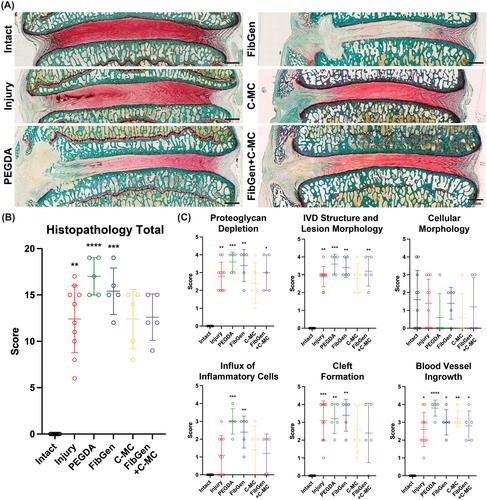Combining adhesive and nonadhesive injectable hydrogels for intervertebral disc repair in an ovine discectomy model
Abstract
Background
Intervertebral disc (IVD) disorders (e.g., herniation) directly contribute to back pain, which is a leading cause of global disability. Next-generation treatments for IVD herniation need advanced preclinical testing to evaluate their ability to repair large defects, prevent reherniation, and limit progressive degeneration. This study tested whether experimental, injectable, and nonbioactive biomaterials could slow IVD degeneration in an ovine discectomy model.
Methods
Ten skeletally mature sheep (4–5.5 years) experienced partial discectomy injury with cruciate-style annulus fibrosus (AF) defects and 0.1 g nucleus pulposus (NP) removal in the L1–L2, L2–L3, and L3–L4 lumbar IVDs. L4–L5 IVDs were Intact controls. IVD injury levels received: (1) no treatment (Injury), (2) poly (ethylene glycol) diacrylate (PEGDA), (3) genipin-crosslinked fibrin (FibGen), (4) carboxymethylcellulose–methylcellulose (C-MC), or (5) C-MC and FibGen (FibGen + C-MC). Animals healed for 12 weeks, then IVDs were assessed using computed tomography (CT), magnetic resonance (MR) imaging, and histopathology.
Results
All repaired IVDs retained ~90% of their preoperative disc height and showed minor degenerative changes by Pfirrmann grading. All repairs had similar disc height loss and Pfirrmann grade as Injury IVDs. Adhesive AF sealants (i.e., PEGDA and FibGen) did not herniate, although repair caused local endplate (EP) changes and inflammation. NP repair biomaterials (i.e., C-MC) and combination repair (i.e., FibGen + C-MC) exhibited lower levels of degeneration, less EP damage, and less severe inflammation; however, C-MC showed signs of herniation via biomaterial expulsion.
Conclusions
All repair IVDs were noninferior to Injury IVDs by IVD height loss and Pfirrmann grade. C-MC and FibGen + C-MC IVDs had the best outcomes, and may be appropriate for enhancement with bioactive factors (e.g., cells, growth factors, and miRNAs). Such bioactive factors appear to be necessary to prevent injury-induced IVD degeneration. Application of AF sealants alone (i.e., PEGDA and FibGen) resulted in EP damage and inflammation, particularly for PEGDA IVDs, suggesting further material refinements are needed.


 求助内容:
求助内容: 应助结果提醒方式:
应助结果提醒方式:


